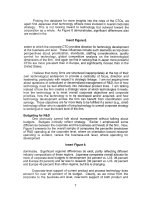Phần 2 Animation of commercial team
Bạn đang xem bản rút gọn của tài liệu. Xem và tải ngay bản đầy đủ của tài liệu tại đây (4.13 MB, 33 trang )
Animation of Commercial Teams
THUONGMAI UNIVERSITY
Hanoi
Licence Professionnelle en Vente
Catherine Glée-Vermande
Course outline
1. What means managing a commercial team ?
Basic nature of management :
Is the management of a commercial team really different from the
management of another team?
History :
Bureaucracy Model and Scientific management
Human Relations Model
Recent trends and new deals
2. Understanding People at Work to increase your efficiency as a manager :
Perception and Attribution
Personality and Emotion
Self awareness
3. From Managing to Leading a Commercial Team
> Motivation
> Leadership , Power and Authority
> Groups dynamic and Communication
> Managing change
1.What means managing a commercial team ?
History :
Through the ages :
different perspectives
and models
The bureaucracy model !
The bureaucratic model of management
Max Weber : a German sociologist who first modelized a
form of organizational structure known as bureaucracy
Bureaucracy : an organizational design developed by Max
Weber that attempts to make organizations operate efficiently
by having a clear hierarchy of authority in which people are
required to perform well-defined jobs.
…..According to Max Weber : the ideal organizational form !
Nature of Bureaucracy
Characteristic
Description
Formal rules
& regulations
Written guidelines are used to control
all employees’ behaviors
Interpersonal
treatment
Favoritism is to be avoided, and all
work relationships are to be based on
objective standards.
All duties are divided into specialized
tasks and are performed by individuals
with the appropriate skills.
Division of
labor
Nature of Bureaucracy
Characteristic
Description
Hierarchical
structure
Positions are ranked by authority level in clear
fashion.
Authority
structure
Decision making is determined by one’s position in
the hierarchy; higher ranking people have authority
over those in lower-ranking positions.
Lifelong career Employment is viewed as a lifelong obligation on
commitment
the part of the organization and employees.
Rationality
The organization is committed to achieving its ends
(profit) in the most efficient manner possible.
Reflection :
Managing a commercial team in a bureaucratic
organizations :
> Do you have examples?
> What do you think ?
• Difficulties?
• Opportunities?
Illustration :IBM in the 70’
History of management :
“Scientific management ” model
Weber & study of bureaucracy :
> An early attempts to apply the scientific method
to the study of work and efficiency.
Central idea : there is an ideal way to efficiently
organize work in all organizations and to manage
people at work
Scientific management
Central problem : making people more
productive!
TAYLOR
TAYLORISM
Scientific management : an early approach to
management and organizational behavior emphasizing
the importance of designing jobs as efficiently as
possible
Key principles/approaches:
> Division of labor : divide work into very specialized tasks so
workers quickly develop efficiency (and are easily replaced)
> Time & Motion Studies: Intense study of the individual
movements needed to perform jobs with the intent of “finding
“the one best way” to perform them
> Standardization: Then apply that one best way to all such
workers.
> Strong hierarchy: it always should be clear to whom each
worker is responsible : which managers have authority over
them.
Scientific Management/Taylorism
Organizations As Machines
Employee as a machine cog !
A black
box
Modern Times
Scientific Management/Taylorism
How does it work?
Targets :………………
Means to achieve targets : …………
Supporting logic : ………………..
Type of mediation between actors : ……………
Material Process (implemented to motivate) :
……………
Symbolic process ( implemented to manage) :
…………
Image of organization : ………………..
Form of appreciation : ………………….
Vision of Human being : …………………..
Scientific Management/Taylorism
How does it work?
Targets : maximum efficiency of each worker
Means to achieve targets : focus on human behavior
and not on person as a whole (mechanistic)
Supporting logic : quantitative
Type of mediation between actors : clear hierarchy
Material Process (implemented to motivate) piece
rate/quantity
Symbolic process ( implemented to manage) : black
box with inputs and outputs
Image of organization : machine
Form of appreciation : money (that’s it)
Vision of Human being : machine “struggle against the
systematic laziness of the worker.”
What about cows? Can they be treated as milk-making
machines?
And what about sales people ?
Can they be treated as “cash machines” ?
> Your ideas and comments…..
Scientific Management : French
approach
The French mindset :
> Henri Fayol : a French industrialist who pioneered various
ideas about how organizations should be structured
Main ideas embedded in the French culture :
> Division of labor : the practice of dividing work into specialized tasks
that enable people to specialize in way they do best (an analytic
perspective/influence of Descartes, the French philosopher – 15961650)
> Strong hierarchical principles : in any organization it always should be
clear to whom each worker is responsible : which managers have
authority over them (an elitist society – the weight of the diploma, of
the status….)









